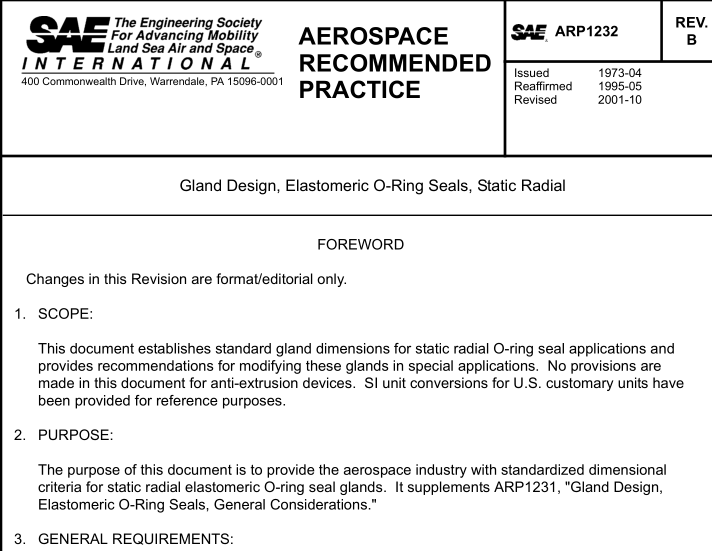SAE ARP 1232:2001 pdf download Gland Design, Elastomeric O-Ring Seals, Static Radial
1. SCOPE: This document establishes standard gland dimensions for static radial O-ring seal applications and provides recommendations for modifying these glands in special applications. No provisions are made in this document for anti-extrusion devices. SI unit conversions for U.S. customary units have been provided for reference purposes.
2. PURPOSE: The purpose of this document is to provide the aerospace industry with standardized dimensional criteria for static radial elastomeric O-ring seal glands. It supplements ARP1231, “Gland Design, Elastomeric O-Ring Seals, General Considerations.”
3. GENERAL REQUIREMENTS:
3.1 Applicable Documents:
3.1.1 ANSI B46.1 – 1962 – Surface Texture
3.1.2 AS568 – Aerospace Size Standard for O-Rings
3.1.3 ARP1231 – Gland Design, Elastomeric O-Ring Seals, General Considerations
3.1.4 ARP1233 – Gland Design, Elastomeric O-Ring Seals, Dynamic Radial
3.2 Gland Configurations:
3.2.1 Standard Glands: Figure 1 depicts rod-mounted and bore-mounted radial O-ring seal glands. Standard dimensions for these glands are tabulated in Table 3. These dimensions are designed for use with seals conforming to AS568 tolerances. They are computed in accordance with the criteria defined in paragraph 4 of this document and in ARP1231.
3.2.2 Exemption: Standard glands are not provided for the larger diameter bore-mounted applications. In these larger sizes, Diameter H becomes larger than the outside diameter of the O-ring seal. This condition makes the installation of a seal impractical. Bore-mounted seal glands have been provided up to those sizes where diameter H is equal to or greater than the seal ID plus 1/2 (seal O.D. – seal I.D.).
3.2.3 Modified Glands: The standard gland dimensions may be modified to achieve an optimum sealing configuration. In selecting or computing gland dimensions, the criteria defined in ARP1231 and in paragraph 4 of this document should be consulted.
3.3 Surface Texture:
3.3.1 Figure 1 defines the preferred surface texture to be used with the glands described in this document. The 63 microinch (1.6 micrometre) texture is satisfactory for most static applications. A 32 microinch (0.8 micrometre) texture may be substituted if there is relative motion between seal and gland sealing surfaces during operation. However, if this relative motion becomes excessive, the application should be considered dynamic and ARP1233 consulted.
4. DESIGN CRITERIA:
4.1 O-Ring Seal Stretch:
4.1.1 Minimum Stretch: Static seals should be stretched a minimum of two percent as installed in the gland. This assures a snug fit in a short time for elastomers such as fluorocarbons which are slow to return to size after stretching.
SAE ARP 1232:2001 pdf download
